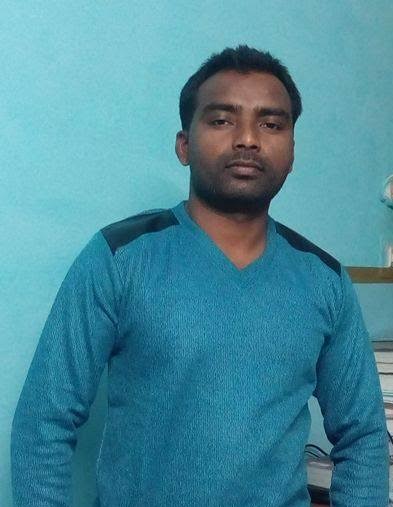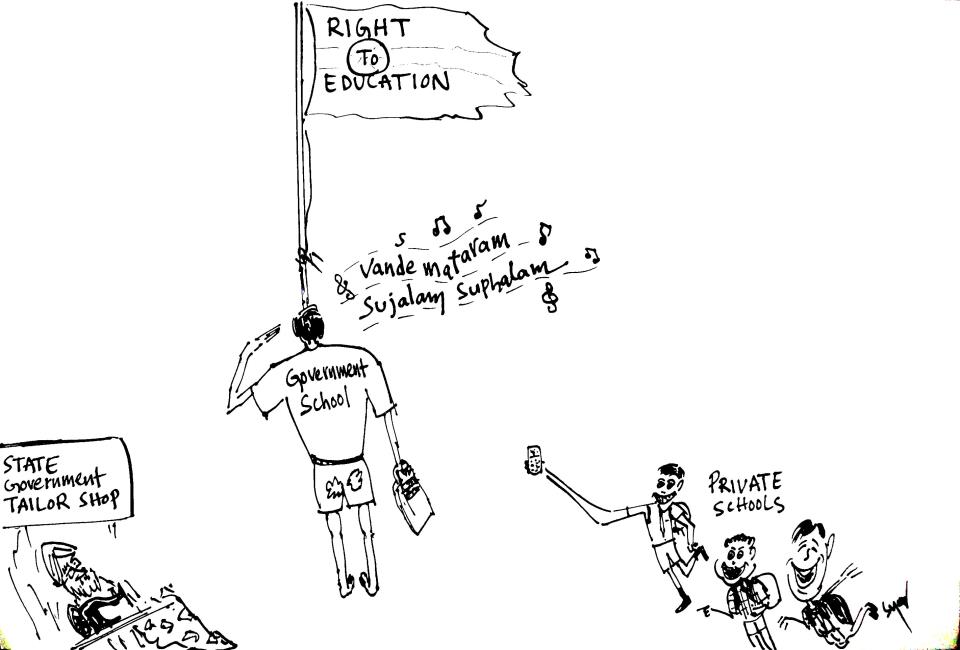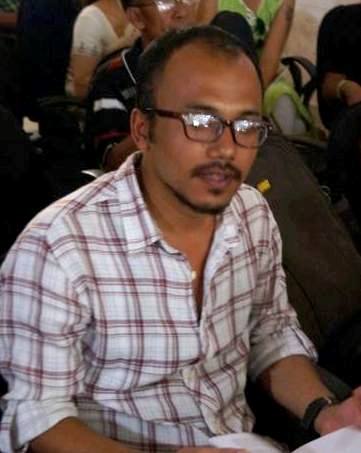Bansidhar Deep
 Recently in Kalahandi, Odisha, Ambedkar’s 125th birth anniversary was celebrated on a big scale. This celebration was deliberated and pre-planned by the Ambedkarite groups at Kalahandi. Ironically, the right wing forces were also celebrating Ambedkar on their platforms for vote bank and other political purposes. Kalahandi is one of the backward districts in India and particularly in Odisha. This district consists of more than 2250 villages and 13 blocks. But the interesting point is that the 125th birth anniversary of Dr. B.R Ambedkar was celebrated in almost every village and block of the district by different groups. This event commenced on 1st April, 2016 from Ampani (village) where the “Buddharaja” temple is located and concluded on 14th April, 2016 at Bhawanipatna (district headquarters) near Rando Majhi chowk with great joy and hope. This procession is known as Ambedkar Jyoti (mashal) jatra, organized by Ambedkar Jayanti Palan Committee. Before starting this event, Ambedkarite groups conducted meetings in every panchayat and block to mobilize the people and make it successful. But simultaneously, other Ambedkarite forces were also celebrating Ambedkar in different places.
Recently in Kalahandi, Odisha, Ambedkar’s 125th birth anniversary was celebrated on a big scale. This celebration was deliberated and pre-planned by the Ambedkarite groups at Kalahandi. Ironically, the right wing forces were also celebrating Ambedkar on their platforms for vote bank and other political purposes. Kalahandi is one of the backward districts in India and particularly in Odisha. This district consists of more than 2250 villages and 13 blocks. But the interesting point is that the 125th birth anniversary of Dr. B.R Ambedkar was celebrated in almost every village and block of the district by different groups. This event commenced on 1st April, 2016 from Ampani (village) where the “Buddharaja” temple is located and concluded on 14th April, 2016 at Bhawanipatna (district headquarters) near Rando Majhi chowk with great joy and hope. This procession is known as Ambedkar Jyoti (mashal) jatra, organized by Ambedkar Jayanti Palan Committee. Before starting this event, Ambedkarite groups conducted meetings in every panchayat and block to mobilize the people and make it successful. But simultaneously, other Ambedkarite forces were also celebrating Ambedkar in different places.
There are two aspects of Ambedkarite movement. Firstly, emancipatory ideals urge Ambedkarites to fight against brahminical social order which is an unegalitarian (oppressive/casteist/misogynist) social order and transform it into an egalitarian social order. Secondly, Ambedkarism is for politics of social justice, dignity and self-respect. However, these two aspects are inseparable. Before beginning to write about Ambedkarite movement and politics in Kalahandi, let me discuss the background of Ambedkarite movement in general.
Background of Ambedkarite Movement
The historical fact is that Ambedkar was born in an untouchable community, “Mahar“. His whole life was full of struggles. Since he was an untouchable, he had to face caste discrimination, untouchability, humiliation, and oppression from upper caste Hindus. Therefore, he had the experience of caste and untouchability. However, through different opportunities in his life, he achieved a status which no Indian could have achieved in that situation. He studied Indian society thoroughly and diagnosed the problem that is Brahmanism. Therefore, he appeals for annihilation of caste. He not only identified the problems, but also discovered the ways through which these problems could be overcome. So throughout his life he tried to find out various ways to annihilate caste system in India. For example, embracing Buddhism and leaving Hinduism, making a democratic constitution where caste/untouchability practices were declared illegal, burning of Manusmriti and so on.
India is a country, where more than six thousand castes exist. And the society has been structured in such a way that lower caste people are looked as inferior by upper-castes and are being dominated in every field. This is seen in politics, education, law, religion, society and so on. Since all the castes are further divided into many castes or sub-castes which are sanctified by Hinduism, there is very little possibility to unite them. This is the reason lower castes are not being able to unite themselves to revolt against upper-castes in this country. Since Indian society is a caste-based society, it is unegalitarian and hierarchical. Hence, it is very difficult to ensure liberty, equality, fraternity and justice for all. Therefore, Ambedkar led his movement for justice, liberty, equality and fraternity both in social and political spheres.
Ambedkar had attempted to unite all the untouchable castes in his movement. Since he had the experience of caste and untouchability during his life, he knew the intensity of caste discrimination, humiliation, exclusion and oppression in India. He says that in India all the lower castes receive the same discrimination from upper caste Hindus. However, as you go down the caste ladder, the caste discrimination is greater in degree and if you go upwards from the bottom, you will face less caste discrimination. In other words, the lower castes (shudra and ati-shudra in Phule’s language) of this country face more caste discrimination than upper castes (baniya, bhumihar, thakur, rajput, kamma and reddy). Therefore, Ambedkar’s theory on caste is an insightful analysis as it is structured on “ascending order of reverence and descending order of contempt”. Of course, caste is not a simple gradation but graded inequality (Ambedkar: 2007: 14). Having discussed the background of Ambedkarite movement in brief, let me now discuss how Ambedkarism is growing in Kalahandi, Odisha.
Emergence of Ambedkarism in Kalahandi
In Odisha, historically there have been many movements against brahmanical culture and politics, such as Buddhism in ancient Odisha, Bhima Bhoi (cultural and religious movement against brahminism) and tribal resistance against brahminical culture. For the first time in Kalahandi, Ambedkarism was introduced by BSP (Bahujan Samaj Party) to make oppressed/suppressed people conscious of politics, society and so on. But now there are many groups which have joined in the activity such as BAMCEF, KMT (Kalinga Mitra Trust), BMP (Bahujan Mukti Party), BVM (Bharatiya Vidyarthy Morcha), Mulnivasi, AIMBSES, and API (Ambedkarite Party of India). Recently, in Odisha and particularly in Western Odisha, Ambedkarism is emerging through various engagements. This engagement we see in terms of celebrating Ambedkar, through different rallies (recently BAMCEF organized a march of 300 bikes at bawanipatna – district head quarter of Kalahandi – on the occasion of Ambedkar jayanti), seminars, discussions, conferences, meetings, creating counter culture by adopting Buddhist practices in marriages and other socio-cultural activities, engaging with Ambedkar in politics, social movements and so on.
Although BSP introduced Ambedkar in Kalahandi, somehow it failed to introduce Ambedkar to the masses. But the recent celebrations of 125th Jayanti of Ambedkar by scattered Ambedkarite groups, have introduced Ambedkar to almost each and every person of the district, at the village, panchayat, block and so on. They visited almost all blocks of the district with band (baja), with some songs on Ambedkar. At night they were screening documentaries, and distributing some literature on Ambedkar as well. Therefore, they have been doing their best to introduce Ambedkar to the masses, which is an achievement for Ambedkarite politics and movement. This event is the making of history for the masses of Ambedkarite movement in Kalahandi and Odisha.
The above-mentioned organizations are working for Ambedkarism in Kalahandi and Odisha in general. But the interesting thing is that Ambedkarism is emerging in both in universities and colleges through students and also in the society at large through other Ambedkarites. One of the achievements of Ambedkarite movement today is that the new-generation, youth and students are more active in understanding Ambedkarism. For example, After Rohith Vemula’s suicide (which was institutional murder) at HCU, a huge number of Ambedkarite-Bahujan students came into the streets all over India, including in Kalahandi.
It is well known that Kalahandi is a district where people are facing discrimination at multiple levels; economically, socially and culturally. For example in this district we see more drought, poverty and starvation; and this shows that they are economically deprived and exploited even though the district has enough natural resources. Lower castes in Kalahandi are marginalized, discriminated, humiliated, and exploited by Brahminism and casteists very severely. Population wise, SC/ST/OBC are majority in this district but the lower castes/ untouchable castes have been facing lot of caste atrocities, caste conflicts, discrimination, exclusion, humiliation and oppression from upper caste Hindus.
Kalahandi district is the part of KBK (Kalahandi, Bolangir and Koraput) area, which means it is one of the most backward and underdeveloped districts in India. In this situation, emerging Ambedkarism in Kalahandi is a good sign for Ambedkarite-Bahujan Movement and its future. This is because celebrating Ambedkar amidst such a brahmanical culture (Jagarnnath and Hindu dominating exploitative/hegemonic culture) is itself a negation of Brahminism. Thus, this is not just a celebration but making people conscious about social, political and cultural issues. I would say this event has prepared a ground in the mass level to annihilate caste system and move forward towards an egalitarian and casteless society. Therefore, these Ambedkarites are creating a counter culture to the hegemonic Brahminic culture. That is why one can see Ambedkarism as the source of social transformation.
Articulating Ambedkarism in Kalahandi
This section is not for criticizing Ambedkarite Movement and politics in Kalahandi but to articulate our own struggle towards Ambedkarism and its missions. The celebration of Ambedkar jayanti is not new either in India or outside of India. In fact, Ambedkar is being celebrated across political party lines, including BJP, Congress and other right wing as well as left wing forces in India. But the fact remains that in the celebration of Ambedkar by untouchable castes, they have attached their emotion to Ambedkar’s ideas and philosophy, as opposed to the celebrations by others and appropriation of Ambedkar for vote bank and other political purposes. This can be seen all over India. Therefore, the question of “self” and ‘other’ becomes important here. Here I see Dalit-Bahujan communities as ‘self’ and upper caste Hindus as ‘other’. The Dalit-Bahujan self is historically and for different reasons attached with Ambedkar’s philosophy of emancipation, unlike Brahmin or so-called upper-caste Hindu thoughts in this country. For example, in recent celebrations of Ambedkar Jayanthi in Kalahandi, it is the SC/ST/OBC groups who participated and celebrated it in large numbers.
For upper-caste Hindus, Ambedkar has become a source of politics. These days, it has become a kind of profession to talk about him in order to mobilize Dalit-Bahujan vote bank in their support. Interestingly, it is not just right wing forces appropriating Ambedkar. The Left is also appropriating Ambedkar for vote bank politics rather than imbibing the Ambedkarite ideas and philosophy. This kind of politics was criticized by Phule-Ambedkar because they have had the experience of caste Hindus and they knew to what extent upper caste Hindus could represent or raise the problems of lower castes. Of course, the upper castes are never ever in favor of the Dalit-Bahujans. In other words, they are always against Phule-Ambedkarite politics and movements. Therefore, Phule speaks of leadership by Shudra and Ati-Shudra (Jotirao Phule 2008: 58), which means the politics of presence in education, politics etc. The same thing is said by Ambedkar, which are self-help, self-struggle, self-knowledge, self-improvement, self-elevation and self-culture (as quoted in Dhananjay Keer 2012: 71-77). Therefore, the masses (SC/ST/OBC and Minorities who are majority of this country) should represent themselves rather than being ‘represented’ by the Hindu upper castes that are in minority in this country. This also needs to be kept in mind by the Ambedkarites everywhere in the country.
In India, among the lower caste and untouchable communities, they have an organic relationship and share similar caste experiences in their life from upper-castes. Because of this, SC/ST/OBCs and minorities are considered as the part of Dalit-Bahujan tradition (in Manyavar Kanshiram’s language). Their history also proves that they are historically linked and united among themselves. But today they are scattered and divided. There is disintegration among different castes as well as within each caste. For example, Schedule Castes are divided into many sub-castes and they are not united. And this is the case for every caste in this country except for the so-called upper castes. This has happened because there is a problem in the structure and system, which is disintegrating people and not letting them get united under one umbrella. We have been finding this pattern in all fields i.e. social, political and so on. This is a big challenge for Ambedkarite politics and movement. This structural problem is not being created by Ambedkarite forces but by the structure. This structure pushes Ambedkar into the particular rather than recognizing him as a mass leader. However, this is a deliberate plan of Brahminism, which narrows down or particularizes Ambedkarite movement and politics. Therefore, Ambedkarite politics of today should understand this problem and be prepared to overcome it at any cost.

Picture of celebration of Ambedkar’s 125th Jayanti, a procession to all villages of the district (Kalahandi)
The most interesting thing in the recent celebration of 125th Jayanti of Ambedkar at Kalahandi is that people from different communities and castes were involved actively in celebrating Ambedkar, although scheduled castes were more in number. This celebration has its own significance, because if we look at the social structure in Kalahandi, there is a lot of conflict within the caste groups and between the caste groups e.g. Scheduled Castes (dombo, ghasi, chamar) who are not getting united. Secondly, SC and ST are antagonistic to each other because of caste factor, although caste is generally taken to be absent in tribal societies. There is conflict between OBC and SC as well. SC/ST/OBC are not united and committing atrocities over the other, but otherwise they are all victimized by Brahminism. Therefore, there is an internal problem within SC/ST/OBC communities on the one hand and Brahminism as an external problem to SC/ST/OBC communities as a whole. This problem needs to be dealt with by Ambedkarites in Kalahandi. That is what one can see in the recent celebration of Ambedkar jayanti in Kalahandi where all these communities participated. I would say this is an initiation to overcome this problem. Therefore, it should be continued. This is what was done by Ambedkar (Annihilation of Caste) and Kanshiram (Jati Todo, Samaj Jodo). Ambedkarism as an ideology will help people unite and annihilate the caste system and gender discrimination. Hence, the first task of Ambedkarite groups anywhere is to express their condition in education, society, economics, politics, and religion and then present the ideologies and philosophies to transcend from those conditions. In other words, Ambedkarites today must follow what Ambedkar had talked about regarding their problems and the solutions to the problems. That is why there is a need to unite on one platform, not because of political purposes but for their emancipation from Brahminism.
In the recent celebrations, many people were part of this but when leaders were addressing the masses they should not be saying or claiming that they are from “Dombo Samaj”, “Adivasi Samaj”, “OBC Samaj” etc, although by default they are. If you are involved in Ambedkarite movement, you should not entertain this development as all of us are for the annihilation of caste. Hence, they must asset, we are Ambedkarite and belong to the Bahujan Samaj, which was led by Buddha, Jotirao Phule, Savitribai Phule, Ambedkar, Bhima bhoi, Kanshiram and so many other social revolutionaries. This is what Ambedkar also said, that there is a difference between consciousness of caste and consciousness of kind or cause (Ambedkar 2007: 18). Therefore, Ambedkarites should overcome narrower states of “Dombo Samaj”, “Adivashi Samaj”, “OBC Samaj” (consciousness of caste) and focus more on consciousness of kind or cause. Only then will we move towards annihilation of caste or Ambedkarism.Picture from Bhawanipatna (district head quarter of Kalahandi), where Ambedkar Jayanti was celebrated.

In this grand celebration, they have done the great work of introducing Ambedkar to the masses, but they have not yet introduced Ambedkarism. That is why I would say this is the initial phase of Ambedkarism in Kalahandi. When these Ambedkarite groups are celebrating Ambedkar, they are not fully aware of the ritualization of his photo during celebration at many places. Ambedkar was against hero-worshiping, but in this celebration one can see that people were cracking coconut in front of his photo and pouring vermilion (sindhur) over it. This is why I would say that they are just introducing Ambedkar to the masses in a brahminical way rather than introducing his ideology and philosophy. And this has happened because of poor leadership, with leaders who are introducing Ambedkar to the masses in the wrong way for different reasons; one of them could be for their own myopic political gains which are individualistic rather than collective.
~
References
Phule, Jotirao. Slavery, Critical Quest, New Delhi, 2008.
Dr. B. R. Ambedkar. Annihilation of Caste, Critical Quest, New Delhi, 2007.
Dr. B. R. Ambedkar. Castes in India, Critical Quest, New Delhi, 2013.
Keer. Dhananjay. Dr. Ambedkar: Life and Mission, Bombay Popoular Prakashan, 2012.
Omvedt, Gail. Dalit Visions, Orient Blackswan, 2010.
~~~
Bansidhar Deep is a Research Scholar at Jawaharlal Nehru University (JNU), New Delhi, a C.C Member of UDSF and is associated with BAPSA.










